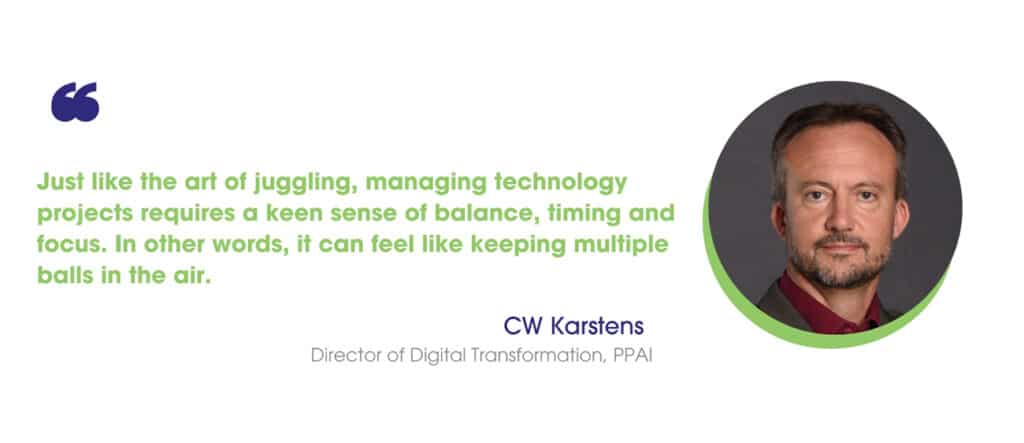One of my many hobbies is juggling. The thrill of being a juggler comes from the intense concentration, coordination and creativity required to keep multiple objects in motion. It’s an exhilarating blend of timing and precision where each successful catch brings a rush of satisfaction. The challenge of mastering new tricks and the artistic expression in creating visually captivating performances add to the excitement.
Just like the art of juggling, managing technology projects requires a keen sense of balance, timing and focus. In other words, it can feel like keeping multiple balls in the air. In the world of tech, these balls represent urgency, impact and effort – each crucial in its own right. Successfully juggling these elements is key to setting optimal priorities and achieving project success.
Each element plays a crucial role in determining how tasks are approached and executed. Here’s a detailed look at these terms and how they interplay in the context of technology projects and issues.
Urgency
Urgency refers to the time sensitivity of a task or issue – how soon something needs to be addressed to avoid negative consequences. In technology projects, urgency often arises from deadlines, regulatory requirements or critical system failures.
For example, if a server hosting a major e-commerce website crashes during peak shopping season, addressing this issue is highly urgent. The immediate focus would be on restoring service as quickly as possible to minimize revenue loss and customer dissatisfaction.
Urgency is typically evaluated on a time scale:
- Immediate
- Short-term
- Medium-term
- Long-term
Immediate issues require action within hours or days, while long-term tasks might span months or years. The key is that urgency focuses solely on the temporal aspect – how quickly action is required.

Impact
Impact assesses the extent of the consequences if a task or issue is not addressed. It measures the significance of the effects on the organization, customers or stakeholders. Impact can be economic, reputational, operational or regulatory.
For instance, a bug in a mobile banking app might have a high impact if it allows unauthorized access to user accounts, leading to financial losses and loss of customer trust. Conversely, a minor typo on a seldom-visited webpage might have a low impact.
Impact is generally classified as high, medium or low. High-impact issues can cripple operations or cause significant financial damage, medium-impact issues cause noticeable disruptions, and low-impact issues have minimal consequences.
Effort
Effort refers to the amount of work required to complete a task or resolve an issue. This includes the time, resources and staffing needed. In technology projects, effort is often measured in work hours, sprints or complexity levels.
For example, implementing a new feature in a software application may require significant development, testing and deployment effort, especially if it involves changes to the core architecture. On the other hand, fixing a minor bug might require minimal effort and be resolved quickly.
High-effort tasks require substantial resources and time, medium-effort tasks require moderate resources, and low-effort tasks are quick and easy to handle.
All Used To Determine Priority
Priority is the overall ranking of a task or issue based on a combination of urgency, impact and effort. It determines the order in which tasks should be addressed to optimize resource use and achieve organizational goals. Priority helps project managers and teams focus on what matters most at any given time.
Priority is often assigned using a matrix that considers urgency and impact, and then adjusts for effort. For instance, a high-urgency, high-impact issue (like a critical security breach) would typically have a higher priority than a high-urgency, low-impact issue (like a minor user interface glitch).
To illustrate, consider two issues:
- A critical database failure (high urgency, high impact, high effort)
- A planned software update (low urgency, medium impact, medium effort)
The database failure would be prioritized because its resolution is critical to maintaining operations and preventing significant loss, despite the high effort required. The software update, while important, can be scheduled later when resources are available.
Ultimately, effective project and issue management in technology relies on a nuanced understanding of these factors, much like a juggler’s keen sense of balance and timing. By carefully evaluating and balancing urgency, impact and effort, teams can ensure that critical tasks are addressed promptly, resources are allocated efficiently, and strategic goals are met.
Just as a juggler captivates an audience with a well-orchestrated performance, tech teams can achieve seamless project execution through skillful prioritization and coordination.
Karstens is PPAI’s director of digital transformation.


